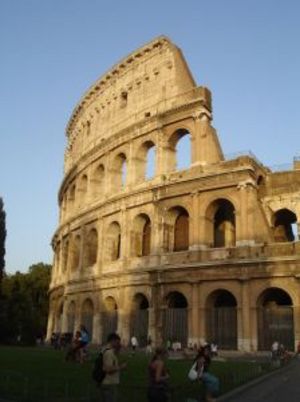The most remarkable civilization to date has been the Roman Empire. It began around 500BC as the Roman Republic and would survive for about 2,000 years. The Empire went through various phases and peaked during the the second century. It controlled over 2.5 million square miles of land and about 100 million people or half of the world’s population. Rome ceased to be an Empire in 476 when the Western Roman Empire fell to Germanic invaders. But much of the influence of Roman culture would remain for another 1,000 years in the form of the Byzantine Empire. Numerous studies have been undertaken to discover the demise of this once great Empire. The most noted historical reference is the book by Edward Gibbon. The Decline and Fall of the Roman Empire is also conceded to be the bible of Roman history. Gibbon’s main theme was that Rome’s decline was the result of a weakened military that had spread it’s resources to thin.
Recent studies by historians and sociologists have come to some different conclusions surrounding the mysteries of the dissolution of the Roman Empire. One historian, Peter Heather, recently published a book called The Fall of the RomanEmpire. He suggests that one of the main reasons for the Empire’s decline was the continuing entanglements with Persian Gulf and Mideast Empires. Others now believe that Roman economics also played a much greater role in the demise of the Empire than was originally believed.
The greatest nation on earth today is the United States. The two main factors supporting this is that the U.S. is the economic leader in the world. Also, at this point in time, the U.S. has the strongest military of any nation. Is there any relevance with what is happening in the United States today and what occurred during the fall of the Roman Empire? One common and provable fact is that in many ways history does have a tendency to repeat itself. Not only on a worldwide scale does this happen, but in the lives of individuals as well. After all, governments and their entities are made up people. And as part of human nature, people are prone to make the same mistakes again and again.
There are four main areas of similarity when contrasting the United States with the Roman Empire. These areas include: government spending, military, taxes and inflation. The following is a brief comparison of what transpired in the later stages of the Roman Empire and the related trends occurring in the U.S. today.
Government Spending
The most significant structures in the Roman Empire were built between 100BC and 200AD. Some were made of solid marble and many still stand today. The famous network of roads, aqueducts, and public baths were also constructed during this time and at great expense. Then in the third century, Rome was forced to spend more on military operations to protect it’s foreign interests and expanding Empire. Greater amounts of money were spent on social services to keep a restless public happy. Less was spent on civic building projects. The infrastructure became neglected. Supporting an army of over 500,000 was a continuing drain on resources. And with promises of pension payments to retired bureaucrats and soldiers, Rome soon dug itself an immense financial hole.
Many of the big cities in the U.S. are experiencing a crumbling infrastructure. The government does not have the resources to rebuild aging cities. Every year, despite what the figures may say, the government spends more than it takes in and continuously promises to make payments in the future to millions of its citizens in the form of pensions and social security benefits. Never mind that these obligations are currently non-funded and will require future taxation to meet. What about the other government colossus, Medicare? Everyday the population of this country ages as millions of baby boomers head toward retirement. An ever increasing cost of health care combined with an aging population that will require more of it, will create a monstrous burden on government resources. Paying for this social health promise will, by itself, have the power to break the government. Throw in national health care down the road and the costs associated with military operation and unkeep…who is going to pay for all these promises?
Military Obligations
Many historians believed that it was the constant fighting with the northern Germanic tribes and the Huns from Eurasia that helped to weaken Rome’s military. But newer studies have concluded that more pressure came from the east. Rome battled the Parthian and Persian Empires for over 600 years. This is now modern day Iraq and Iran. Eventually Rome would end up fighting with most of the Middle Eastern countries as we know them today. These wars lasted until about 650 and became a huge drain on financial resources.
Flash forward to today and we find this same region as the cause for much of the world’s turmoil. The U.S. now has a direct presence in the Middle East which is draining hundreds of billions of dollars from taxpayers. Further involvement might be required to protect American oil interests in the region. Several additional military encounters might be forced upon the U.S. such as protecting Israel or invading Iran. Then there is North Korea to consider and the possible rearming of Russia to contend with. The U.S. military machine is stretched very thin right now across the globe. And with no foreseeable end to the threat of terrorism and Middle East conflicts, Americans will forced to pay up in the form of higher taxes.
Escalating Taxes
In early Roman times, taxes were minimal and often inconsequential. The Roman Empire was able to create economic prosperity for its citizens. The economy continued to grow until the burden of maintaining the military forced Rome to raise taxes. Land and inheritance taxes were substantially increased forcing many of Rome’s middle class into bankruptcy. Then followed the upper classes as overall tax burdens became to great. Soon, government revenues began to decrease because fewer citizens could afford to pay taxes. This led to Rome’s ultimate demise since it could no longer pay its military or the hired mercenaries protecting the northern borders.
Despite what the politicians say about lowering taxes, most Americans are still burdened by over-taxation. The average worker spends the first four months of the year working for good old Uncle Sam. After that, he gets to keep his hard earned wages to some extent. Then when he goes to spend those wages, he ends up paying numerous additional taxes. Along with the expanding military and social programs, somewhere down the line, taxes will have to be significantly raised. Or, benefits will have to be drastically reduced. When was the last time the politicians had the nerve to do either? Their main goal is to maintain popularity, not cause pain and suffering by making the difficult choices. There is a way out though….inflation!
Over-inflating the Economy
The Roman government was no different than any other in the history of the world. To attempt to pay for it’s obligations, it simply created more money. This debasing of the currency was seen in Rome’s most common coin. The denarius had a 90% silver content during the age of Nero in about 60AD. Two centuries later, its silver content was only 0.2%. The value of silver exploded and so did commodity prices. It is estimated that a measure of Egyptian wheat that once cost 8 drachmas in the first century, rose in price to 120,000 drachmas. This type of irresponsible government policy has occurred throughout history. The results are always the same.
Raise your hand if you think the real rate if inflation is this country is only about 3%. Energy, housing, schooling, medical, and insurance costs, to name a few, are rising much faster than 3%. Yet, our government says inflation is under control. Back in 2000, a dollar could buy 1.21 euros. Today, it only buys .79 cents. That is inflation because it now takes more dollars to buy one euro. The government knows it is backing itself into a corner that will leave no way out. To pay for its towering obligations and future promises it can only raise taxes or inflate the economy. There is always hope that the economy can continue to grow and produce enough tax revenue to out-pace the financial burdens. But this will not occur when tax dollars are wasted on military and social programs. And the government insists on spending more than it takes in thus creating a negative cash flow. Somewhere down the line someone will have to pay off these gargantuan debts.
These trends have been continuing for many decades. It does not matter which party is running the show. We are still very much in a tax-and-spend-then-inflate situation. This same scenario has been played out in one form or another throughout history. Just because we are the greatest nation on earth doesn’t mean we will escape economic catastrophe. Irresponsible governments and their policies cannot survive indefinitely. It might have taken 2,000 years for Rome to eventually suffer the consequences. However, today’s world moves much faster than in Roman times.
The individual can maintain a positive and optimistic attitude. Through wise and prudent actions, one may avoid the consequences of a government whose spending is out of control. Cut your expenses and prepare for your own future. Pay down your debts and finds ways to increase income that can be used for saving and investing. Otherwise, become like a politician and stick your head in the sand. Then repeat to yourself… it can’t happen here…it can’t happen here…can it?









